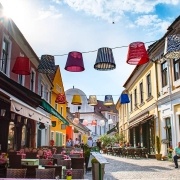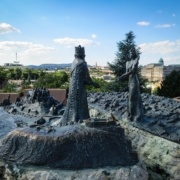Urban Legends of Budapest
They say that truth should never get in the way of a good story, and this holds true for Budapest’s urban legends. Some of these tales have survived for centuries, while others are more recent additions. Interestingly, some of them might even be true!
We adore urban legends because they entertain, challenge, and connect both locals and travelers in Budapest.
Lions on the Chain Bridge with a Tongue-in-Cheek Twist
Legend has it that these lions don’t have tongues, and their sculptor suffered quite the embarrassment. But here’s the scoop: The artist, János Marschalkó, did give those lions tongues, and he enjoyed a long, hearty life, making it to 58.
Those lions do have tongues, they’re just not sticking them out. Marschalkó found the legend hilarious and would quip: “I am not a butcher, to loll out big tongues for smoking”
By the way, when you’re in Budapest, don’t miss our Free Budapest Tours. We’ll show you all the cool spots, including the cheeky lions on the Chain Bridge. Come join the adventure!
The Buda Castle Tunnel: Where Bridges Take Cover!
It’s a legend worth knowing! This tunnel connects the Buda side of the Széchenyi Chain Bridge with the areas behind the Buda Castle Hill. It’s about 350 meters long, nearly as long as the Chain Bridge itself. But here’s where it gets fun: According to local folklore, when it rains, the Chain Bridge cozies up in this tunnel! Imagine a massive bridge taking a nap down there.
The tunnel was built for both cars and people, so you can walk through it. However, we’d suggest not doing that because, well, drivers can be a bit wild, and the space for pedestrians is quite narrow. Plus, the ventilation is not exactly a breath of fresh air.
Take our daily Free Buda Castle Hill Tour. We wrap up the tour right above the tunnel, where you can snap beautiful photos of the Chain Bridge and the Castle Hill funicular. Just remember, next time it rains, the Chain Bridge might be taking a cozy nap in the tunnel below!
The Tale of the Forever Waiting Maid
Now, let’s dive into a touching story from Budapest’s 14th district, also known as Zugló. Just head to 61 Thököly Street. Picture a building with a unique balcony and a statue of a woman gazing down at the streets. This place is home to a legendary tale, all about true love.
During World War I, this building belonged to a young couple. When the war began, the man had to head off to the frontlines, and his beloved stayed behind, their reunion a promise. But then, the heartbreaking news arrived: her love was lost in battle. She couldn’t accept it, believing he was still out there somewhere. So, she made the balcony her second home, spending every moment looking down at the street, hoping to spot her beloved.
Tragically, during her vigil, the Spanish flu arrived in Hungary, taking many lives. The young maid fell ill, but even on her deathbed, she clung to hope, still waiting for her love to return. The bittersweet twist? Just a few days after the maid’s passing, her love did return from the war. Overwhelmed with sorrow, he couldn’t bear the thought of anyone else on that balcony. So, he built a statue in her memory and sealed it off the balcony, forever preserving the faithful maid’s love.
This touching legend continues to warm the hearts of those who hear it.
The Wacky Witches of Gellért Hill
Gellért Hill’s name comes from a monk, St. Gerard, who came to Hungary in 1015 to convert the pagan Hungarians to Christianity and teach the crown prince. But here’s where things get wild: the pagan Hungarians didn’t exactly embrace his teachings. They killed the crown prince and put the monk in a barrel, sending him down the Danube River to meet his maker.
For centuries, Gellért Hill was rumored to be the ultimate witches’ hangout. Fast forward to 1728, and Hungary had its most famous witch hunt. Twelve witches were put on trial and, well, they didn’t have a magical escape plan. They were sentenced to death!
But here’s the head-scratcher: Why would witches choose a hill named after a Christian saint for their meetings? Well, it’s all in the geography. The hill had these hot springs (Matthias, Rákóczi, and Árpád springs), which meant there was sulfuric steam and some mysterious caves.
Perfect for a little hocus-pocus, right?”
The Tale of the Turul Bird
Let’s meet the Turul bird, the mystical bird of prey with a tale to tell. In one story, Princess Emese, linked to Attila the Hun’s legacy, had a dream worth sharing. She dreamed of a Turul bird that appeared and, surprisingly, made her pregnant. Her dream wasn’t just a dream; she gave birth to Álmos, a prominent leader of the Hungarian people. They even named him after her dream. It’s like being named after your mom’s wildest bedtime story..!
There’s another tale about the Hungarian tribes. The Hungarian tribes needed to move on, and the Turul showed the way, leading them to their new home, which we now call Hungary. The bird dropped a sword on the land as a sign for the tribes to settle down here.
A feathered guide our ancient GPS.
Take our daily Free Buda Castle Hill Tour to see the bird and learn more about the Hungarian history.













